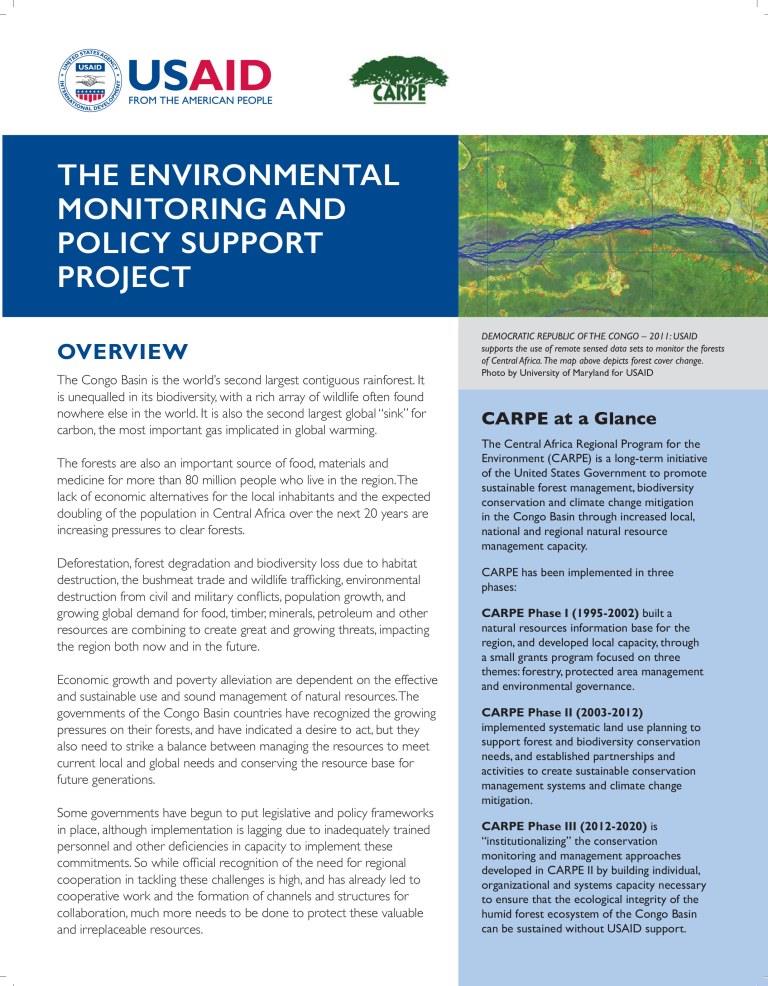OVERVIEW
The Congo Basin is the world’s second largest contiguous rainforest. It is unequalled in its biodiversity, with a rich array of wildlife often found nowhere else in the world. It is also the second largest global “sink” for carbon, the most important gas implicated in global warming.
The forests are also an important source of food, materials and medicine for more than 80 million people who live in the region. The lack of economic alternatives for the local inhabitants and the expected doubling of the population in Central Africa over the next 20 years are increasing pressures to clear forests.
Deforestation, forest degradation and biodiversity loss due to habitat destruction, the bushmeat trade and wildlife trafficking, environmental destruction from civil and military conflicts, population growth, and growing global demand for food, timber, minerals, petroleum and other resources are combining to create great and growing threats, impacting the region both now and in the future.
Economic growth and poverty alleviation are dependent on the effective and sustainable use and sound management of natural resources. The governments of the Congo Basin countries have recognized the growing pressures on their forests, and have indicated a desire to act, but they also need to strike a balance between managing the resources to meet current local and global needs and conserving the resource base for future generations.
Some governments have begun to put legislative and policy frameworks in place, although implementation is lagging due to inadequately trained personnel and other deficiencies in capacity to implement these commitments. So while official recognition of the need for regional cooperation in tackling these challenges is high, and has already led to cooperative work and the formation of channels and structures for collaboration, much more needs to be done to protect these valuable and irreplaceable resources.
In 1995 USAID established the Central Africa Regional Program for the Environment (CARPE), a 25-year program aimed at reducing the threats of forest and biodiversity loss within the Congo Basin. CARPE aims to slow the rate of forest degradation and the impact it can have on climate change by increasing local, national and regional capacity and participation in natural resource management, and strengthening conservation policy development and implementation.
CARPE’s approach is both top-down and bottom-up. It works at the local level with forest dwelling communities and at the national level with an array of international, regional, national and local partners to transition from the past spiral of environmental degradation and poverty toward a trajectory characterized by climate resilience and rising earnings from sustainable low emissions development and flourishing biodiversity.
Now in its third phase, CARPE is “institutionalizing” the management of the Congo Basin forests through individual, organizational and systems capacity building. To achieve this, two distinct but interdependent projects have been established: the Environmental Monitoring and Policy Support (EMAPS) project, which works to boost the quality and scope of conservation policy-making, and forest monitoring, analysis and information dissemination; and the Central Africa Forest Ecosystems Conservation (CAFEC) project.
THE ENVIRONMENTAL MONITORING AND POLICY SUPPORT PROJECT
The Environmental Monitoring and Policy Support (EMAPS) project is developing Central Africa’s national and regional policy and regulatory capabilities. Better policies and implementing frameworks, along with new remote sensing technologies, help improve forest and biodiversity monitoring and conservation, allowing for state-of-the-art analysis of forest cover change, greenhouse gas (GHG) emissions, carbon sequestration and other environmental benchmarks.
To achieve this, EMAPS concentrates on two key objectives to meet the goal of maintaining the ecological integrity of the humid forest ecosystem of the Congo Basin.
The first is to create policy and regulatory environments that support sustainable forest and biodiversity conservation management. EMAPS does this by strengthening local, provincial, national and regional institutions to formalize and enforce forest, biodiversity and global climate change (GCC) policies, improving local civil society’s ability to successfully engage in public dialogue and disseminate relevant information, and by increasing community-based organizations’ knowledge of forestry, biodiversity and GCC policies and regulations.
The second is to strengthen the capacity to measure, monitor, report and verify forest cover change, forest-based GHG emissions and carbon sequestration and biodiversity at local, national and regional levels. EMAPS does this by increasing access to technologies and methodologies for natural resource and biodiversity monitoring and GCC mitigation.
The Congo Basin forest presents huge logistical challenges to the collection of reliable and current data on biodiversity status and threats. To meet these challenges, EMAPS strengthens the ability of local and national institutions to use satellite data and geographic information systems to inform both conservation and management efforts and policy-making.
A partnership between National Aeronautics and Space Administration (NASA), the University of Maryland (UMD), and the Central Africa Forest Satellite Observatory (OSFAC) has produced detailed analyses of forest cover and loss across the Congo Basin. These analyses are key reference documents for Central African countries developing national baselines of forest carbon stocks and emissions for their national climate change mitigation programs. The work is complemented by the U.S. Forest Service, which provides technical assistance, as well as helping to build local institutional and community capacity.
To complement the forest cover monitoring and analysis work implemented under EMAPS, USAID funds the development of national interactive forest atlases. These atlases show the location, extent and different land use and land rights classifications, including logging concessions, in relation to protected areas and other land uses. They also identify risks to protected areas including illegal cutting, mineral extraction, and road construction.
EMAPS also works with the Congo Basin Forest Partnership to promote the sustainable management of the Congo Basin’s forests and wildlife across country borders by improving communication, cooperation and collaboration.








Comment
Make a general inquiry or suggest an improvement.